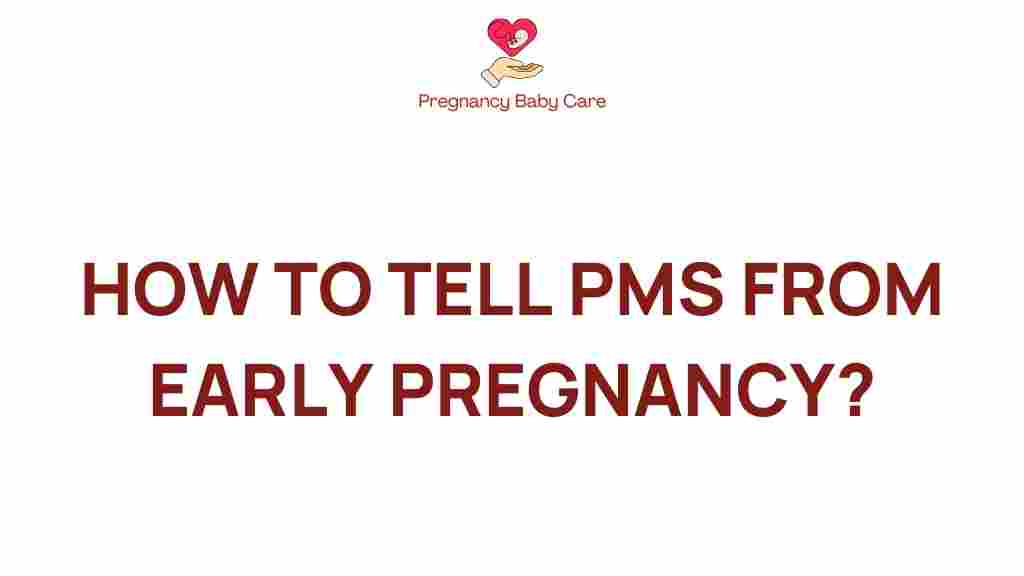PMS or Early Pregnancy: How to Distinguish Between the Two?
When it comes to women’s health, distinguishing between premenstrual syndrome (PMS) and early pregnancy can be challenging. Both conditions share similar symptoms, largely due to hormonal changes occurring in a woman’s body. Understanding these differences is essential for those trying to conceive or simply monitoring their menstrual cycle. This article will guide you through the symptoms of PMS and early pregnancy, helping you navigate this confusing time.
Understanding PMS and Early Pregnancy
PMS is a collection of physical and emotional symptoms that many women experience in the luteal phase of their menstrual cycle, typically one to two weeks before menstruation. Early pregnancy, on the other hand, refers to the initial stages after conception, usually within the first few weeks. The symptoms can overlap significantly, making it difficult to determine the underlying cause.
Common Symptoms: PMS vs. Early Pregnancy
Identifying the signs of PMS and early pregnancy can be tricky. Here are some common symptoms associated with both:
- Cramps: Both PMS and early pregnancy can cause abdominal cramps.
- Bloating: A feeling of fullness or swelling in the abdomen is common in both cases.
- Breast Tenderness: Hormonal changes can lead to breast sensitivity or tenderness.
- Fatigue: Tiredness is prevalent in both PMS and early pregnancy.
- Mood Swings: Emotional fluctuations can occur due to hormonal changes in both conditions.
- Food Cravings: Women may experience cravings or aversions to certain foods.
Key Differences in Symptoms
While many symptoms overlap, several key differences can help you distinguish between PMS and early pregnancy:
- Timing: PMS symptoms typically appear 5-10 days before menstruation, while early pregnancy symptoms may begin shortly after implantation, around a week after conception.
- Menstrual Cycle: If your period is late or missed, it may indicate early pregnancy. In contrast, PMS symptoms will resolve with the onset of menstruation.
- Nausea: Morning sickness in early pregnancy can manifest as nausea and vomiting, particularly in the morning, which is not typical with PMS.
- Increased Urination: Early pregnancy can cause frequent urination due to hormonal changes and increased blood flow to the kidneys.
- Changes in Smell: Many women experience heightened sensitivity to smells during early pregnancy, a symptom not usually associated with PMS.
Hormonal Changes and Their Effects
Understanding hormonal changes can shed light on the symptoms experienced during PMS and early pregnancy. Here’s a brief overview:
- PMS: During the luteal phase of the menstrual cycle, levels of progesterone rise, which can lead to mood changes, bloating, and breast tenderness. When menstruation occurs, hormone levels drop, alleviating these symptoms.
- Early Pregnancy: After conception, hormone levels, particularly human chorionic gonadotropin (hCG), rise rapidly. This hormone is responsible for many early pregnancy symptoms, including nausea and breast tenderness.
Diagnosing PMS vs. Early Pregnancy
If you find yourself uncertain about whether you are experiencing PMS or early pregnancy, here are steps you can take:
- Track Your Menstrual Cycle: Keeping a diary of your menstrual cycle can help you identify patterns and determine whether your symptoms align with your cycle.
- Take a Pregnancy Test: If you suspect you may be pregnant, taking a home pregnancy test can provide clarity. These tests measure the levels of hCG in your urine.
- Consult a Healthcare Provider: If symptoms persist or worsen, it’s advisable to speak with a healthcare provider. They can perform blood tests and provide comprehensive evaluations.
When to Seek Medical Advice
While PMS and early pregnancy are common, there are instances where symptoms may warrant a visit to a healthcare professional. Consider seeking advice if you experience:
- Severe abdominal pain or cramping
- Heavy bleeding or spotting
- Severe mood swings that impact daily life
- Signs of pregnancy, such as dizziness or fainting
Getting timely advice can help ensure your health and well-being.
Tips for Managing Symptoms
Whether you are dealing with PMS or early pregnancy symptoms, here are some tips to manage discomfort:
- Dietary Changes: Eating a balanced diet rich in fruits, vegetables, and whole grains can help manage symptoms. Limit caffeine and sugar intake.
- Exercise: Regular physical activity can alleviate cramps and boost mood. Aim for at least 30 minutes of moderate exercise most days.
- Stress Management: Techniques such as yoga, meditation, or deep breathing exercises can help manage emotional symptoms.
- Hydration: Staying hydrated can reduce bloating and fatigue.
- Supplements: Consider discussing with your healthcare provider about vitamins and supplements that may help alleviate PMS symptoms.
Conclusion
Distinguishing between PMS and early pregnancy can be challenging due to the overlapping symptoms. By understanding the nuances of each condition, tracking your menstrual cycle, and being aware of your body’s hormonal changes, you can better identify what you’re experiencing. If uncertainty remains, consulting a healthcare provider is always a wise choice to ensure your health is prioritized.
For more information on women’s health, fertility, and managing menstrual symptoms, check out this comprehensive guide. Additionally, you can explore general insights about early pregnancy signs here.
Remember, knowledge is power, and understanding your body is key to maintaining good health.
This article is in the category Pregnancy and created by PregnancyBabyCare Team
